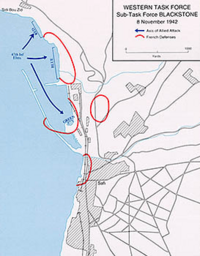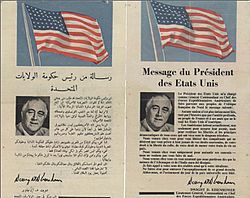Operation Blackstone facts for kids
Quick facts for kids Operation Blackstone |
|||||||
|---|---|---|---|---|---|---|---|
| Part of Operation Torch of the North African Campaign of World War II | |||||||
 A map showing landings during the operation |
|||||||
|
|||||||
| Belligerents | |||||||
|
|||||||
| Commanders and leaders | |||||||
| Strength | |||||||
| Ground forces: 6,400 troops Naval activity: 8 warships 6 transports |
Ground forces: 300 troops 3 tanks shore batteries and artillery pieces |
||||||
| Casualties and losses | |||||||
| US: 3 dead 25 wounded |
France: 300 troops captured |
||||||
Operation Blackstone was a part of Operation Torch, the Allied landings in North Africa during World War II. The operation called for American amphibious troops to land at and capture the French-held port of Safi in French Morocco. The landings were carried out by the 47th Infantry Regiment of the U.S. Army and took place on the morning of 8 November 1942 as part of a larger operation to capture Casablanca.
The landings from converted destroyers were mostly successful. They were initially conducted without covering fire, hoping that the French might not resist at all. When coastal batteries opened fire, the fleet returned fire. When commanding General Harmon arrived French snipers had pinned the assault troops (most of whom were in combat for the first time) on the beaches. Most of the landings occurred behind schedule; air support from the carriers destroyed a French convoy of trucks intended to reinforce the defenses.
Safi surrendered on the afternoon of 8 November, but sporadic resistance continued until 10 November when the remaining defenders were pinned down and the bulk of Harmon's forces raced to join the siege of Casablanca.
Background
Algeria became a French colony in 1830 after France invaded and captured Algiers. After the fall of France to the Nazi Germany and then under Vichy France rule, Algeria and French North Africa came under German control. The Allies freed Algeria of Nazi rule with Operation Torch that started on November 8, 1942. Operation Torch also freed Morocco and French North Africa.
Operation Torch landings in Algeria were focused on Oran, Algiers, as the Oran had two airfields. Oran surrendered on 9 November 1942, one day after the 8 November landings. The American forces led by Lloyd Fredendall, seized Oran from the Vichy troops in two days. Many of the Vichy troops had Allied sympathies. Algeria was needed to fight the Afrika Korps, and for planes to fly from South American bases. contr
Before the Vichy French surrendered they destroy the Oran harbor facilities and disable the Vichy ships at the docks.
Operation Terminal and Operation Reservist, were part of Operation Torch, the goal was to capture Algeria and French North Africa port facilities before they could be destroyed, both failed at their goal, but the ports were secured and repaired.
After the Vichy French surrendered the Clark-Darlan Negotiations were held in the Hotel St. Georges on 10 November between US General Mark W. Clark and French Admiral François Darlan. In the end, the negotiations gave the outcome they were looking for: ceasefire in Oran and Casablanca, the French African army would help the Allies fight the Nazis, help unload Allied cargo ships, and use of French trains to support the troops. On 24 December 1942, pro-monarchist Fernand Bonnier de La Chapelle assassinated Darlan in his headquarters, but the negotiations agreements continued.
See also
- US Naval Bases North Africa
- 17th Armored Engineer Battalion
- 82nd Armored Reconnaissance Battalion


